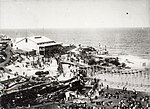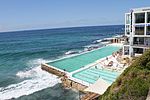Little Boy Lost (sculpture)
Buildings and structures in SydneyOutdoor sculptures in AustraliaSculpture stubs
Little Boy Lost is a sculpture created by the Australian artist Paul Trefry for the "Sculpture by the Sea" exhibition on Bondi and Tamarama beach, in 2009. It is an over–sized silicone rubber and fiberglass sculpture made to resemble a toddler of approximately 18 months to 2 years of age, and for the duration of the exhibition, it was situated on Tamarama Beach, to the South of Bondi.
Excerpt from the Wikipedia article Little Boy Lost (sculpture) (License: CC BY-SA 3.0, Authors).Little Boy Lost (sculpture)
Thompson Street, Sydney Tamarama
Geographical coordinates (GPS) Address Nearby Places Show on map
Geographical coordinates (GPS)
| Latitude | Longitude |
|---|---|
| N -33.9003 ° | E 151.2705 ° |
Address
Tamarama Beach
Thompson Street
2026 Sydney, Tamarama
New South Wales, Australia
Open on Google Maps










